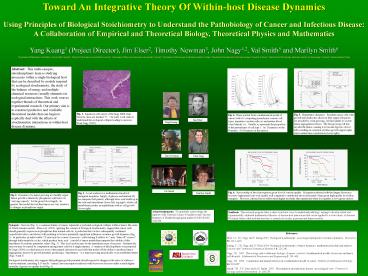Toward An Integrative Theory Of Withinhost Disease Dynamics - PowerPoint PPT Presentation
1 / 1
Title:
Toward An Integrative Theory Of Withinhost Disease Dynamics
Description:
Toward An Integrative Theory Of Within-host Disease Dynamics ... Synopsis: Necrosis (Fig. 1), a common feature of cancer, represents a profound ... – PowerPoint PPT presentation
Number of Views:53
Avg rating:3.0/5.0
Title: Toward An Integrative Theory Of Withinhost Disease Dynamics
1
Toward An Integrative Theory Of Within-host
Disease Dynamics
Using Principles of Biological Stoichiometry to
Understand the Pathobiology of Cancer and
Infectious Disease A Collaboration of Empirical
and Theoretical Biology, Theoretical Physics and
Mathematics
Yang Kuang1 (Project Director), Jim Elser2,
Timothy Newman3, John Nagy4,2, Val Smith5 and
Marilyn Smith6
1Department of Mathematics and Statistics,
Arizona State University 2School of Life
Sciences, Arizona State University 3Department
of Physics and Astronomy, Arizona State
University 4Department of Life Sciences,
Scottsdale Community College 5Department of
Ecology and Evolutionary Biology, University of
Kansas 6Department of Microbiology, Molecular
Genetics and Immunology, University of Kansas
Medical Center
Abstract This multi-campus, interdisciplinary
team is studying processes within a single
biological host that can be described by models
inspired by ecological stoichiometry, the study
of the balance of energy and multiple chemical
resources (usually elements) in ecological
interactions. This work weaves together threads
of theoretical and experimental research. Our
primary aim is to construct predictive and
verifiable theoretical models that can begin to
explicitly deal with the effects of
stoichiometric interactions in within-host
disease dynamics.
Acknowledgements We gratefully acknowledge the
support of the National Science Foundation and
National Institutes of Health through grant
number DMS/NIGMS 0342388.
Synthesis This research program takes a step
toward new ways to understand pathology, aiming
to develop robust and experimentally calibrated
mathematical theories of disease-host
interactions that can be applied to a wide
variety of diseases. We firmly believe that such
theories have a central role to play in present
and future research.
Synopsis Necrosis (Fig. 1), a common feature of
cancer, represents a profound ecological collapse
within a tumor, the cause of which remains
unclear. Elser et al. (2003), applying the
concept of biological stoichiometry, suggest that
cancer cells should generally require more
phosphorus than normal cells do, a prediction
that we have subsequently confirmed (unpublished
data), and shown with modeling to be have
potentially significant influences on tumor
growth dynamics (Fig. 2). In particular, an
unfavorable CP ratio may be a cause of
necrosiscells lacking P relative to C may burn
off excess C through futile metabolic cycles,
which produce lactic acid. A model of tumor
metabolism supports the viability of this
hypothesis for realistic parameter values (Fig.
3). This local acidosis may be the immediate
cause of necrosis. Alternatively, necrosis may
be caused by competition among tumor cells for a
single nutrient. A variation of this hypothesis
was proposed by Nagy (2004), in which necrosis
arose when natural selection favored cells that
traded off the ability to produced tumor
angiogenesis factors for growth potential,
producing a hypertumor, or a tumor growing
parasitically on an established tumor (Figs. 4
and 5). Biological stoichiometry also suggests
that pathogen growth potential should respond to
changes in the ratios of carbon to various
nutrients, including P, N and Fe. Indeed, larval
mosquitoes infected with Beauvaria bassiana
suffer a much higher mortality if given
low-quality food (Fig. 6).
References Elser, J.J., J.D. Nagy and Y. Kuang
2003. Biological stoichiometry an ecological
perspective on tumor dynamics. Bioscience 53
1112-1120. Kuang, Y., J.D. Nagy and J.J. Elser
2004. Biological stoichiometry of tumor
dynamics mathematical models and analysis.
Discrete and Continuous Dynamical Systems B 4
221-240. Nagy, J.D. 2005. The ecology and
evolutionary biology of cancer a review of
mathematical models of necrosis and tumor cell
diversity. Mathematical Biosciences and
Engineering 2 281-418. Nagy, J.D. 2004.
Competition and natural selection in a
mathematical model of cancer. Bulletin of
Mathematical Biology. 66 663-687. Smith, V.H.,
T.P. Jones and M.S. Smith. 2005. Host nutrition
and infectious disease an ecological view.
Frontiers in Ecology and the Environment. 3
268-274.































